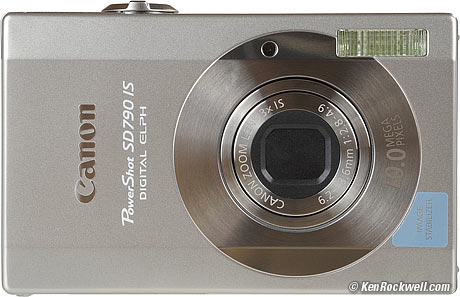Canon
SD790 IS
(IXUS 90 IS)
© 2008 KenRockwell.com. All rights reserved.
Canon SD790 IS. enlarge.
I'd order mine from Adorama or Amazon. It helps me keep adding to this site when you get yours from these links, too.
May 2008
Introduction top
Intro Specs Performance Recommendations
The Canon SD790 is a very competent pocket camera with image stabilization for low-light shots without flash. It has a huge, brilliant screen and it feels great to use.
The SD790 was announced on 12 March 2008. As of May 2008, it's selling for about $310.
Specifications top
Intro Specs Performance Recommendations
Name: Canon calls this the PowerShot SD790 IS Digital ELPH Camera.
Resolution: 10MP, menus permit shooting at lower resolutions.
Lens: 3x optical zoom, 35-105mm equivalent.
Image Stabilization: YES.
LCD: 3."
Peephole Viewfinder: NO.
Battery: NB-5L, 1120 mAh, included.
Charger: CB-2LX, included.
Included: An almost useless 32MB SD memory card, a USB interface cable, a video playback cable, a wrist strap, and a software CD.
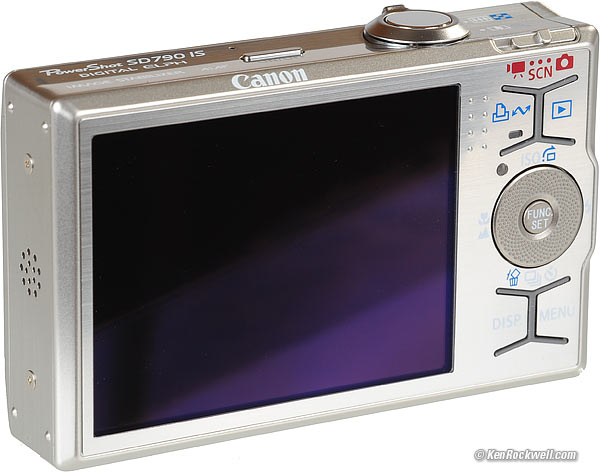
Canon SD790 IS (larger than life).

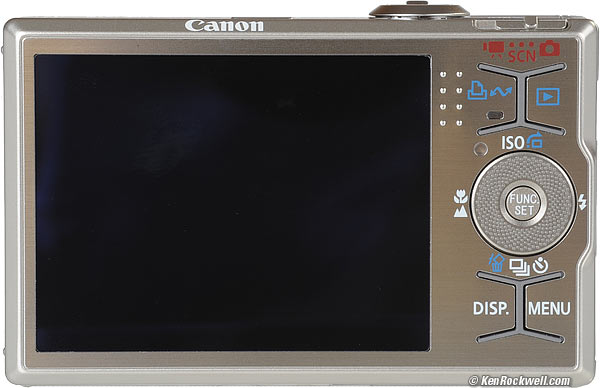

Canon SD790 IS.
Performance top
Intro Specs Performance Recommendations
LCD
The LCD is delicious. It's half the reason to buy the SD790.
The LCD is bright, sharp, contrasty, accurate and brilliant.
It's accurate from any angle. It gets dimmer when seen from the side, but the colors and contrasts are unchanged. This is fantastic!
The 3" LCD is so bright and vivid it's almost as if it's alive and three-dimensional. I wish Canon's SLRs had LCDs this good; the LCD on my 5D sucks.
Holding the SD790's LCD next to my calibrated Apple 30" monitor, they match very closely, except that the SD790 is both brighter (for daylight legibility) and a little more contrasty (in addition to a brighter backlight, the blacks can be a little deeper since the SD790's screen is anti-reflection-coated).
My only complaints about the LCD can also be taken as compliments. The SD790's LCD has colors slightly more vivid than perfectly accurate, which means that things can look a little better on the back of the SD790 than the actual image file.
Yellows especially tend to be displayed a little more vividly than actually in the file, as compared to my calibrated monitor. Sometimes the color balance of the SD790's LCD can tend towards a little too much yellow, but this is only obvious if you're doing a direct side-buy-side comparison of the SD790 to a calibrated professional monitor with the same image files.
The SD790's LCD is among the most accurate I've used, short of the LCDs on Nikon DSLRs (but the Nikon aren't as accurate when seen at screwy angles). The SD790's LCD is bright enough to seen in sunlight, and accurate enough to let me make critical exposure, contrast, saturation, color balance and white balance adjustments while shooting. There's no need to wait to see the images on a laptop screen.
Speed
The SD790 is reasonably fast in responding to my inputs. This, and the much bigger LCD, are the two big reasons I greatly prefer it to the less expensive SD770.
Shutter delay isn't an issue if you use it properly.
Ergonomics
Ergonomics are good on the SD790. I love the power switch on top.
It's fast to respond to button commands.
I like the new bent-metal buttons which replace Canon's usual captive-dot buttons. They feel more solid than the little captive buttons Canon uses on other cameras.
Canon has made the round four-way control a spinning knob! This sounds great on paper, but in practice, isn't very good.
The problems with the rotating rear command dial are that it's too slow, it has no clicks, its ponderous and imprecise, and the fatter dial now means that the critical central "FUNC. SET" button had to be made too small.
No big deal, I simply ignore the new command dial and drive the camera normally.
The SD790 has Canon's usual superior controls and features. For instance, you can assign the PRINT button to do your bidding while shooting; I program mine for instant access to exposure compensation. Like Casio, the PLAY button now will turn on the camera without needing the power button to extending the lens.
Canon still lags behind Casio; you have to push the PLAY button after a shot to play other images.
Image Quality
Like a typewriter, the quality of what's created has a lot more to do with the photographer than with the camera.
As far as noise and sharpness, technical image quality is the same as most other compact cameras. It's very sharp, but much noisier (grainier) than the images from any digital SLR. There is the usual distortion (bulging at the wide end and none at tele) and the edges can have just a hint of lateral color if you look too hard.
It's clean enough at ISO 80 in daylight, but noisy at ISO 200. This is the way compact digital cameras have been for a long time.
When shooting at smaller resolutions, the SD790 correctly creates images even sharper (pixel-by-pixel) than at larger resolutions. This is because Bayer Interpolation goes away when set to smaller resolutions.
Color
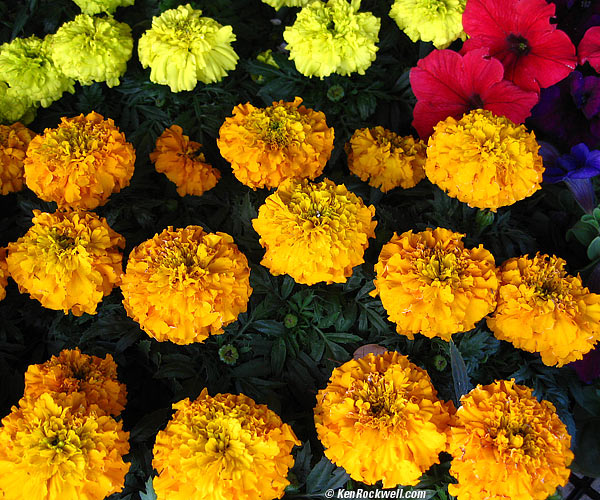
Made in "Vivid" mode.
Colors matches all the other Canon compacts, which means I can create wild, vivid colors if I want to.
I like vivid colors, so I set the Vivid mode. You do this by:
1.) Press FUNC. SET.
2.) Click down to OFF.
3.) Click right to Vivid.
4.) Press FUNC.SET to exit.
Fill Flash (using flash with daylight)
Balance between flash fill and ambient light is better than I've seen before, but compact cameras still aren't great compared to DSLRs.
Auto White Balance
Auto White Balance is better than previous compacts, and far better than most DSLRs, under artificial light.
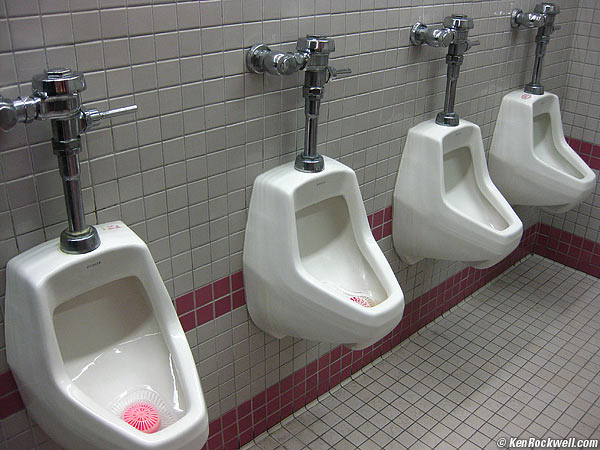
The Toilet Test: Passed with flying colors! (AWB, Auto ISO chose ISO 200.)
These white urinals look white, as they should. They are under nasty fluorescent light. This is great; most other cameras look ghastly green or orange under crappy light like this.
Why show urinals in a family website? Because public bathroom lighting is the worst light I can find to strain AWB systems, and these are clean urinals — note the fresh mints in each.
Sharpness
Its lens and files are very sharp.
Even at macro range, everything is limited only by your photographic abilities, not by this camera.
Image Stabilization (IS)
Image Stabilization (IS) works great.
I usually get perfectly sharp shots hand-held at 1/8 second at the wide end.
Panoramic Stitching and QTVRs
You get to the Stitch Assist mode by turning the rear dial with the top slide switch slid to the red camera position.
The SD790 comes with free Canon Photostitch v3.2 software which lets you create all sorts of panoramas. I've never bothered with a tripod; I shoot these freehand.
The software lets you create all sorts of outputs. Have fun!
Battery Life
There is a three-segment battery-state indicator on the LCD (press DISP a couple of times if you can't see it).
I used the SD790 for a week, made 400 shots and videos with it and spent plenty of time playing in the menus and playing images and kid videos. The battery gauge still read full.
Autorotation
By default, the files have a flag set if they're vertical. Like other cameras, you still need to rotate these later to ensure that they will always play as verticals everywhere.
Pointed down, it often gets confused and flags horizontal shots as if they were vertical, requiring file repair later. My Nikon D3 does the same thing.
Image Playback
There are too many display modes. It takes forever to sequence through them with the DISP button.
It cannot playback h.264 .MOV files recorded on a Casio EX-V8. It treats them as if they don't exist, even if on a card inserted in to the SD790.
Video
Video files unfortunately have file numbers unrelated to the still images.
Video quality is excellent, meeting modern broadcast standards (which no longer exist) once converted, but use more file space than other pocket cameras. A 10-second clip at the default setting (640x480 @ 30 FPS) is 19MB.
Sound Recording
The SD790 records mono sound as WAV files at 44.100, 22.050 and 11.025 KSPS. At 44.1k the files have full LF bandwidth, while 11.025k limits both the low and high ends.
Sadly they are only recorded via a hidden menu under the playback menu, and the files are hidden in a separate folder with file names and files numbers completely unrelated to the rest of the images.
Gain is rather high; if you hold the camera up to your mouth you may clip, and the AGC isn't very happy either. Stand back and it loves to take in the whole room.
The only way to play the files in-camera is by finding that hidden option again in the playback menu.
You can record a "sound memo" after about 10 clicks in the menus to correlate with an image (contrast this to the Nikon D3 which does it with just one dedicated button). If you can figure out how to record the memo, you'll find it in the same folder and with the same number, but unfortunately prefixed with "SND_" instead of "IMG_." This means the sound files will never catalog along with the images. Again, the Nikon D3 does it right by having the file names and locations of the sound files match the image to which they apply, and differ only in suffix (.WAV instead of .JPG).
Mechanics
The Canon SD770 is a quality product that feels like it has a lot of metal. The case seems like stainless steel. The screen is anti-reflection coated.
Recommendations top
Intro Specs Performance Recommendations
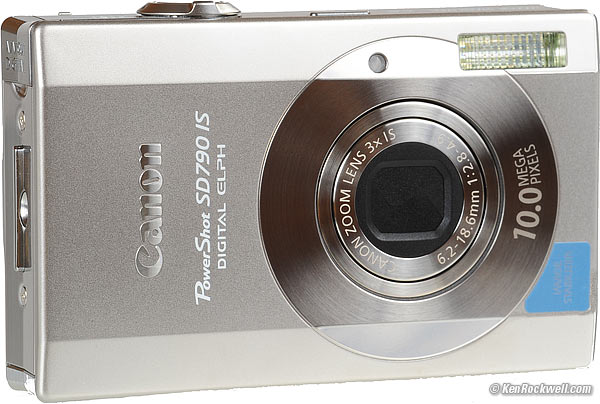
Canon SD790 IS.
I like the SD790 IS. It's a huge improvement over the $50 less expensive SD770 because of the huge LCD screen and much faster operation. The SD790 has a lot more computing horsepower than does the SD770.
If you can afford it, get the SD790. If money matters, consider saving even more money with the Canon SD750. The SD750 lacks IS, but has a huge screen. IS is for people like me who shoot indoors without flash. Most people who shoot on the default auto flash position would never take advantage of IS.
I prefer the SD790 to the $50 more expensive SD890 because of the bigger screen. I don't need the longer zoom of the SD890 as much as I love thelarger screen.
This camera has no 100-year-old style peephole viewer. I use the LCD.
If I needed to buy another compact camera (they come out faster than I can destroy them, so I don't need another one for myself today), I'd get this SD790 and skip the SD770 and SD890. For less money, or if I didn't shoot indoors without flash, I'd look at the SD750.
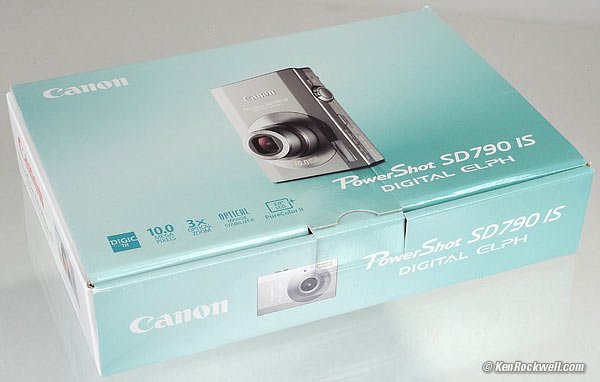
Box, Canon SD790 IS.
Hint 1: 10MP is too much resolution for almost everything people shoot with compact cameras. 10MP takes up too much needless space on hard drives. I shoot the SD790 turned down to 6MP (2,816 x 2,112 pixels), and to NORMAL (staircase icon), not the default 10 MP and FINE (quart-circle icon) when I shoot it. This is still plenty of pixels for great 12x18" enlargements.
Hint 2: For vivid colors, I set the VIVID mode. To get into it as well as most of the settings photographers need, you have to get the SD790 into its manual mode. You do that by:
1.) Set the top slide switch to the red camera icon.
2.) Rotate the big back ring clockwise to the icon of the camera with an "M."
3.) Press FUNC. SET and click down two to OFF.
4.) Click one to the right to V - VIVID
5.) Press FUNC SET again to set it.
I also set the PRINT button for immediate access to exposure compensation (the control that makes the picture darker or lighter). To do this,
1.) Be in a picture-taking (not play) mode.
2.) In the red camera menu, click one up to "SET ~ BUTTON."
3.) Set to taste. I set to Exp. COmp (+/-).
Note that you also can set this button to CUSTOM WB. If you do this, one tap of the print button is all you need to do to measure and set a custom gray-card WB to anything at which the camera is pointed. This is a very useful feature which is much easier than doing thins on any Nikon DSLR, and worlds easier than on any Canon DSLR. This unfortunately shows us that the DSLR and Powershot people probably don't go out for sake together: each group has much they could learn from the other.
Any questions? From the USA, Canon has excellent support. Phone them at (800) OK-CANON with any questions about how to use your camera.
PLUG
If you find this as helpful as a book you might have had to buy or a workshop you may have had to take, feel free to help me continue helping everyone.
Thanks for reading!
Ken




